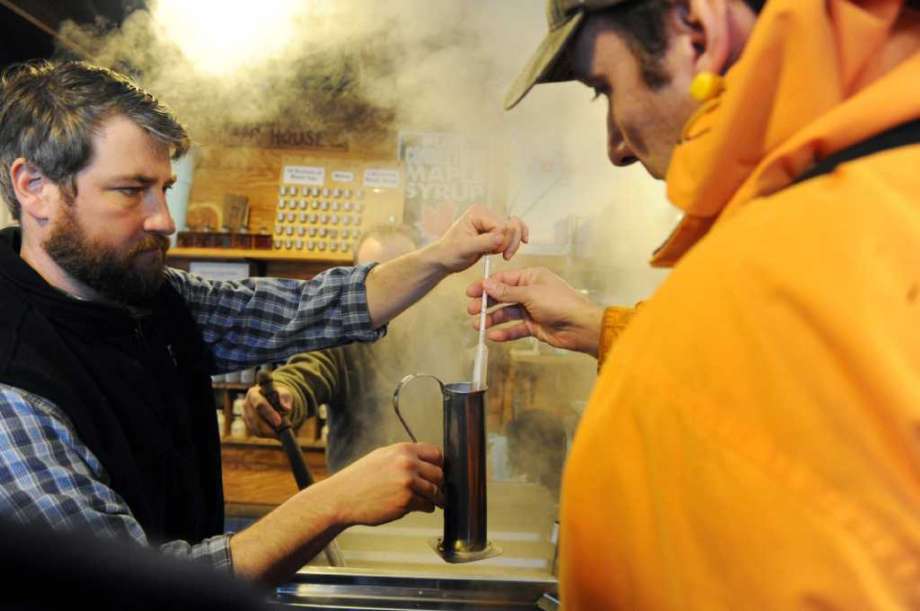Sweet Fun on Tap at the Nature Center
Will Kies, left, Director of Education at the Stamford Museum and Nature Center, shows Dino Psichopaidas a hydrometer which is used to measure the thickness of syrup during Maple Sugar Sunday the center in Stamford, Conn., March 6, 2011. Maple Syrup Sunday is an annual event focusing on the deeply rooted New England tradition of maple sugaring.
STAMFORD — After visiting the Sugar Shack on Heckscher Farm to watch maple syrup be boiled from raw sap, Kristina Long, 8, and her 6-year-old sister, Charlotte, warmed up with some maple-flavored corn dogs on sticks at the Stamford Museum & Nature Center’s Bendel Mansion.
“We like maple syrup with our pancakes,” Charlotte said. “It tastes great.”
Their father, Robert Long, said it was interesting to watch the labor-intensive process required to produce syrup.
“I tried to buy some Mrs. Butterworth but now the girls won’t eat anything with pancakes and waffles but maple syrup,” Long said.
Dozens of families turned out for Maple Sugar Sunday at the nature center Sunday, an annual event that offers demonstration of modern and historical methods of making maple syrup and a chef’s challenge, pitting the maple-syrup based dishes of two catering businesses against one another.
Maple syrup season runs from about mid-February to late March, education director Will Kies said.
The cook-off, introduced last year, was won by Marcia Selden Catering and Event Planning of Stamford, which offered maple-glazed popcorn with prosciutto, maple-flavored corn dogs with a dipping custard, and maple whoopie cakes crusted with pecans.
The other contender, David’s Soundview Catering of Stamford, whipped up a maple syrup vegetable stew, with kidney beans, brussel sprouts, beets, carrots, and assorted muffins with maple butter.
Erik Anderson, the executive chef for David’s, said maple syrup is a good soup and stew ingredient because it accents the natural sweetness of vegetables.
“All the vegetables in the soup are associated with winter and the maple syrup just adds a real comforting and earthy tone to the whole dish,” Anderson said.
Rain-splattered children and parents huddled into the Sugar Shack to watch Kies and others use an evaporator to boil maple sap into syrup, a process that requires about 40 gallons of sap to produce a single gallon of syrup with a concentration of 67 percent sugar and 33 percent water.
Children sampled maple-flavored candies and sampled syrup from thimble-sized cups.
“That’s what I’m talking about,” Danny Miller, 12, a member of Boy Scout Troop 11, said as he drank a cup of syrup.
Native Americans introduced settlers to converting maple sap into sugar, and used a method of putting hot rocks into the sap to boil it before transferring the partially separated sap into clay pots for further boiling, said Pat Standaert, a museum employee.
The two-step process was required because the clay pots couldn’t endure the extended boiling process, Standaert said.
“They made mostly maple sugar rather than syrup because they didn’t have a way to preserve the syrup very long,” Standaert said.
In the Sugar Shack, Kies ran the nature center’s evaporator, a boiling machine powered by wood that separates the syrup from the sap.
“It depends on how the weather holds up but right now we’re on track for a really good season,” Kies said.
Maple syrup produced from sap harvested later in the season, which has a lower sugar content, is a darker amber color because the boiling process takes longer and concentrates the syrup more, Kies said.
Boy Scouts from Troop 11 boiled sap in a large copper vat under a wood fire outdoors, and would later transfer the concentrated syrup to a smaller fire to be concentrated further, the boys explained.
“It’s a lot of work but it’s worth it for the taste,” said Jack Houtz, a 14-year old troop member.
Melissa Mulrooney, executive director for the Stamford Museum & Nature Center, said the syrup will be sold at the center’s gift shop and at the Bendel Mansion, and sells out in most seasons.
Staff Writer Martin B. Cassidy can be reached at martin.cassidy@scni.com or at 203-964-2264.

